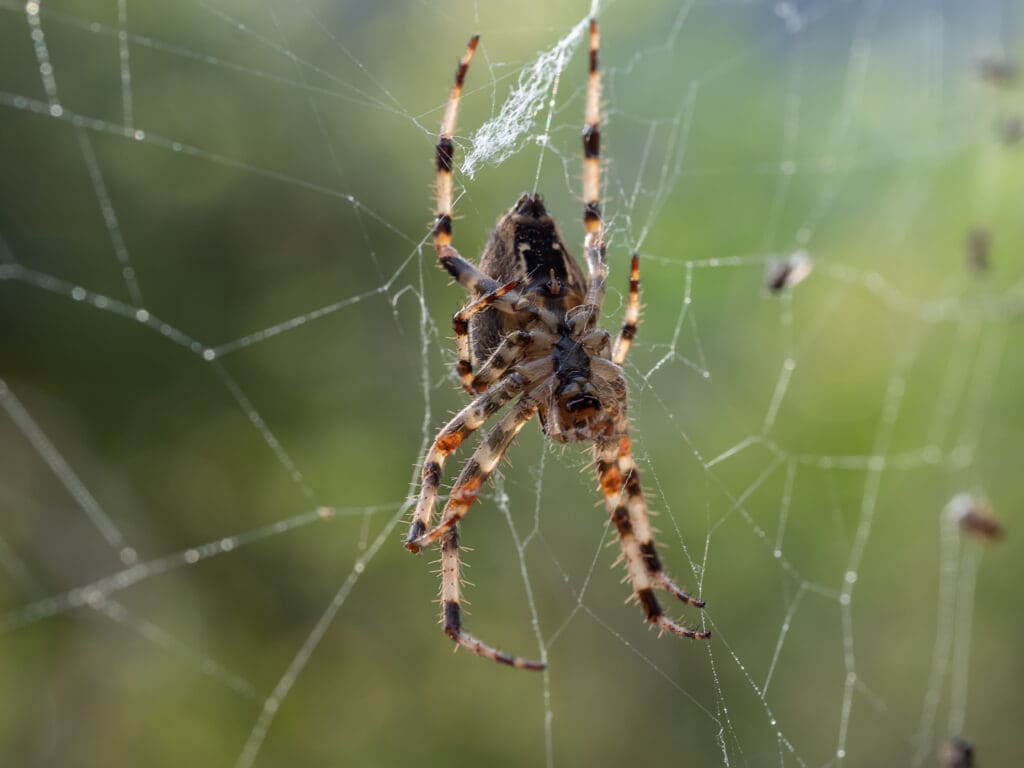
Aranea diadema
Latin name: Aranea diadema
Short name: Aran
Common name: Cross Spider | European Garden Spider | Diadem Spider | Orb-weaver Spider | Crowned Orb-weaver
Primary miasm: Malarial Secondary miasm(s): Sycotic, Tubercular
Kingdom: Animals
Family: Araneidae
- Symptomatology
- Remedy Information
- Differentiation & Application
Aranea diadema is a large orb-weaving spider native to Europe, easily recognised by the white cross-shaped markings on its abdomen. In homeopathy, the remedy is prepared from the live spider, macerated in alcohol. It belongs to the Araneidae family, known for their intricate wheel-shaped webs. In toxicology, spider venom contains neurotoxic components that can affect nerve conduction and vascular tone. Hahnemann and later observers noted its peculiar affinity for producing periodic, chill-dominated states.
No direct medicinal use in conventional medicine; in folklore, spiders were sometimes used in charms or as part of traditional poultices for intermittent fevers. Naturalists value the spider for pest control.
Introduced into homeopathy by Nunez in the early 19th century; symptoms confirmed by later provers, including French and German homeopaths. Much of the materia medica record is clinical, based on its efficacy in intermittent fevers and neuralgias.
- Vascular system, particularly venous circulation and capillaries.
- Nervous system, especially sensory and motor nerves, producing periodic neuralgias.
- Bone tissue, with peculiar deep, boring pains in long bones.
- Spleen and portal system.
- Thermoregulation centres, with a strong influence on chill-fever-sweat cycles.
- Lying in a warm room during chill stage.
- After eating, in some neuralgic conditions.
- Continuous gentle motion during bone pains.
- Cold, damp weather, especially fog and wet seasons.
- At the same hour every day (periodicity).
- Rest during neuralgic pains.
- Exposure to cold air after being heated.
- Approach of stormy weather.
- Eupatorium perfoliatum – Bone pains with fever, but Eupatorium has greater thirst and more prominent heat stage.
- China officinalis – Malarial intermittents with marked debility and bloating, but China has more sweat and less marked aggravation from damp.
- Natrum muriaticum – Periodic fevers with splenic tenderness, but with strong emotional component and dryness.
- Cedron – Periodicity to the minute, but more neuralgic in face and temples.
- Complementary: Natrum muriaticum, Eupatorium perfoliatum.
- Antidotes: China officinalis.
- Follows well: Quinine abuse cases.
The essence of Aranea diadema is coldness and periodicity — bone-deep chill at the same hour daily, often linked to damp climates or marshy exposures. The patient is never truly warm; every draught or damp day revives the same cycle of symptoms. Venous congestion, splenic enlargement, and bone pains tie the remedy to malarial constitutions.
Indispensable in stubborn intermittent fevers where quinine has failed, especially if damp, foggy weather aggravates and if chill predominates. Valuable in neuralgias with clock-like periodicity. Chronic rheumatic states with aggravation from dampness may also benefit. Often prescribed in 3rd to 6th decimal potencies, though higher potencies may be used in chronic periodic neuralgias.
Mind
- Indifference during chill.
- Difficulty concentrating during fever.
Head
- Periodic headache at same hour daily.
- Band-like sensation across forehead.
Eyes
- Vision blurred during fever.
- Lachrymation in damp weather.
Stomach
- Nausea before chill.
- Appetite poor during fever.
Skin
- Cold, damp skin during chill.
- Mottled discolouration from venous stasis.
Extremities
- Deep bone pains, periodic.
- Cold hands and feet during chill.
Generalities
- Complaints periodic, at same hour daily.
- Aggravated by damp, fog, and wet weather.
Hering – The Guiding Symptoms of Our Materia Medica: Emphasis on periodicity, coldness, and bone pains.
Clarke – A Dictionary of Practical Materia Medica: Detailed malarial and neuralgic applications.
Allen, T. F. – Encyclopaedia of Pure Materia Medica: Original proving data and clinical confirmations.
Boericke – Pocket Manual of Homœopathic Materia Medica: Concise keynote on chill predominance.
Hughes – Cyclopaedia of Drug Pathogenesy: Venous and periodic action confirmed.
